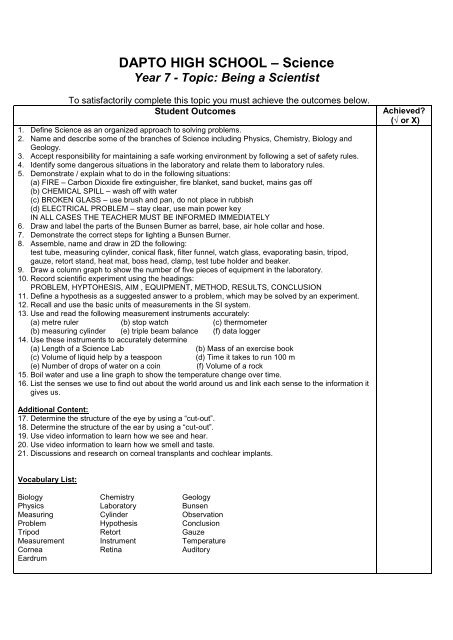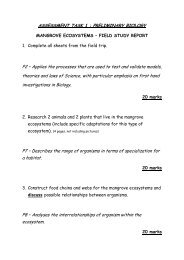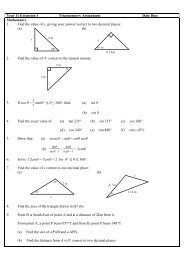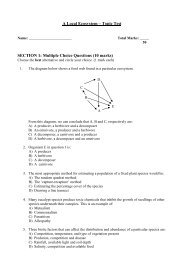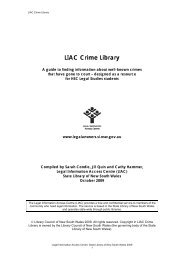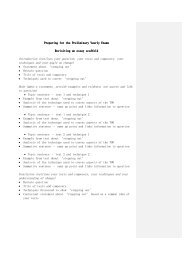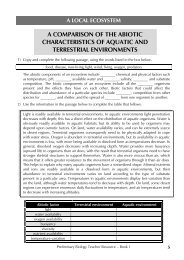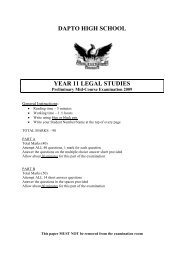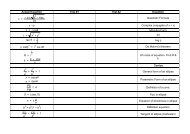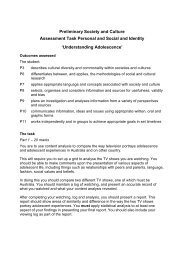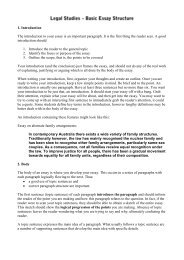DAPTO HIGH SCHOOL – Science Year 7 - Topic: Being a Scientist
DAPTO HIGH SCHOOL – Science Year 7 - Topic: Being a Scientist
DAPTO HIGH SCHOOL – Science Year 7 - Topic: Being a Scientist
- No tags were found...
You also want an ePaper? Increase the reach of your titles
YUMPU automatically turns print PDFs into web optimized ePapers that Google loves.
<strong>Topic</strong> Test: ___/50Bookwork : Satisfactory UnsatisfactoryAttitude : Satisfactory UnsatisfactoryAssessments : Satisfactory Unsatisfactory________________________Teacher Signature________________________Parent/Guardian SignatureSelf-reflectionMy achievements for this unit are:__________________________________________________________________________________________________________________________________________________________________________________________________________________________________________________________________________________________________________________I need to improve in the following area:________________________________________________________________________________________________________________________________________________________________________________________________________________________________________One way I can improve:____________________________________________________________________________________________________________________________________________________________________________________________________________________________________________________
Self-reflectionMy achievements for this unit are:__________________________________________________________________________________________________________________________________________________________________________________________________________________________________________________________________________________________________________________I need to improve in the following area:________________________________________________________________________________________________________________________________________________________________________________________________________________________________________One way I can improve:____________________________________________________________________________________________________________________________________________________________________________________________________________________________________________________
<strong>DAPTO</strong> <strong>HIGH</strong> <strong>SCHOOL</strong> <strong>–</strong> <strong>Science</strong><strong>Year</strong> 7 - <strong>Topic</strong>: What is Energy?To satisfactorily complete this topic you must achieve the outcomes below.Student Outcomes1. Define energy as the ability to do work or to cause change and it is measured in joules.2. Identify that technologies make tasks easier or more convenient.3. Describe that energy changed when it is used from one form to another.4. Identify 10 different forms of energy.5. Account for total energy involved in energy transfers and transformations.6. Identify kinetic energy as energy of motion and potential energy as energy due to other properties.7. Label a diagram to show how PE changes to KE and vice versa when a brick falls and a pendulumfalls.8. Identify energy changes inside and outside the laboratory.9. Identify a variety of energy transformations in everyday devices involving electrical, sound light and/orheat energy.10. Use models to describe different forms of energy.11. Make energy converters, which change:electrical to heat <strong>–</strong> radiatorelectrical to sound <strong>–</strong> speakersolar to electrical <strong>–</strong> solar cellsheat to electrical <strong>–</strong> thermocoupleheat to kinetic <strong>–</strong> automobile enginechemical to heat <strong>–</strong> striking a match12. Describe a problem and develop a hypothesis or question that can be tested or researched.e.g. use a pendulum to show conversion of KE and PE.13. Identify possible sources of information or data relevant to the investigation.14. Identify what type of information or data needs to be collected.15. Justify why particular types of data or information are to be collected.16. Identify the appropriate units to be used in collecting data.17. Follow a planned procedure when performing an investigation e.g. identify 10 devices in the homethat transform energy, draw a flow chart of energy changed that occur in a power station.18. Use time and resources effectively.19. Safely and efficiently construct, assemble, and manipulate identified equipment.20. Record using the appropriate units.21. Describe (using examples including those developed by Aboriginal peoples) ideas developed bydifferent cultures to explain the world around them.22. Describe historical cases where developments in science have led to the development of newtechnologies.23. Identify and describe examples where technological advances have impacted on science.Achieved?(√ or X)<strong>Topic</strong> Test: ___/50Bookwork : Satisfactory UnsatisfactoryAttitude : Satisfactory UnsatisfactoryAssessments : Satisfactory Unsatisfactory________________________Teacher Signature________________________Parent/Guardian Signature
Self-reflectionMy achievements for this unit are:__________________________________________________________________________________________________________________________________________________________________________________________________________________________________________________________________________________________________________________I need to improve in the following area:________________________________________________________________________________________________________________________________________________________________________________________________________________________________________One way I can improve:____________________________________________________________________________________________________________________________________________________________________________________________________________________________________________________
<strong>DAPTO</strong> <strong>HIGH</strong> <strong>SCHOOL</strong> <strong>–</strong> <strong>Science</strong><strong>Year</strong> 7 - <strong>Topic</strong>: Hot StuffTo satisfactorily complete this topic you must achieve the outcomes below.Student Outcomes1. Recall that there are three states of matter and that the particles of matter are continuously movingand interacting.2. Realise that a changed in the amount of energy processed by particles determines the amount oftheir movement.3. Measure and graph the temperature at which ice melts to demonstrated the melting point of a solid.4. Measure and graph the temperature at which wax freezes to demonstrate the freezing point of aliquid.5. Determine the effect of salt on the boiling and freezing points of water.6. Compare the cooling effect of evaporation of various liquids including water and ethanol.7. Observe the condensation of water vapour into a liquid.8. Understand the differences between evaporation and boiling.9. Understand the concept of latent heat, and that energy must be lost or gained during changes ofstate.10. Carry out an experiment to demonstrate the latent heat of water as it boils.11. Observe the sublimation of various substances from solid to gas/gas to solid, including sulfur,naphthalene, iodine, carbon dioxide (dry ice).12. Explain that pressure Is caused by colliding particles pushing against surfaces.13. Understand the relationship between pressure, force and surface area.14. Observe the effects of air pressure at work, including suction disks, Magdeburg hemispheres and a“crushing can”.15. Know that air pressure is measured by barometers.16. Know some common units of air pressure, including millibars, hectapascals, mmHg and atmospheres17. Relate differences in air pressure to differences in weather patterns, so know about isobars.18. Boil water under reduced pressure, so understand that boiling point depends on ambient pressures.19. Understand that density is a measure of mass/volume.20. Measure the masses (using a digital balance) and volume of common substances (by difference ifnecessary) and determine their density in grams/mL, including water, ice, salt, sand, rubber stopper,rock.21. Understand that a less dense substance floats on a more dense substance.22. Float different concentrations of salt water on each other.23. Know that the Dead Sea is very dense, so that a person cannot sink in it.24. Know what Plimsoll lines are and what they are used for.25. Make a Cartesian diver and use knowledge of pressure and density to explain how it works.Achieved?(√ or X)<strong>Topic</strong> Test: ___/50Bookwork : Satisfactory UnsatisfactoryAttitude : Satisfactory UnsatisfactoryAssessments : Satisfactory Unsatisfactory________________________Teacher Signature________________________Parent/Guardian Signature
Self-reflectionMy achievements for this unit are:__________________________________________________________________________________________________________________________________________________________________________________________________________________________________________________________________________________________________________________I need to improve in the following area:________________________________________________________________________________________________________________________________________________________________________________________________________________________________________One way I can improve:____________________________________________________________________________________________________________________________________________________________________________________________________________________________________________________
<strong>DAPTO</strong> <strong>HIGH</strong> <strong>SCHOOL</strong> <strong>–</strong> <strong>Science</strong><strong>Year</strong> 7 - <strong>Topic</strong>: Energy on the MoveTo satisfactorily complete this topic you must achieve the outcomes below.Student Outcomes1. Associate energy with energy transfers in a simple circuit.2. Construct and draw simple circuits to show transfer of energy.3. Identify that sound requires a medium in which to travel (propagation).4. Describe light as a form of energy not requiring a medium for propagation.5. Define conduction as movement of heat in solids by vibrations between particles.6. Define good and bad conductors (insulators).7. Describe uses for insulation <strong>–</strong> why animals may have thick fur coats, how are house kept cool.8. Define convection as movement of heat in liquids and gases.9. Describe how sea-breezes occur due to convection.10. Describe radiation as movement of heat where no particles are present.11. Describe differences between absorption, reflection and transmission of radiation.12. Follow the planned procedure when performing an investigation.13. Use time and resources effectively.14. Safely and effectively construct, assemble and manipulate identified equipment.15. Record data using appropriate units.16. Identify and describe examples where technological advances have impacted on science.- space and reentry (Space Shuttle)- thermos flasks- nuclear weaponsAchieved?(√ or X)<strong>Topic</strong> Test: ___/50Bookwork : Satisfactory UnsatisfactoryAttitude : Satisfactory UnsatisfactoryAssessments : Satisfactory Unsatisfactory________________________Teacher Signature________________________Parent/Guardian Signature
Self-reflectionMy achievements for this unit are:__________________________________________________________________________________________________________________________________________________________________________________________________________________________________________________________________________________________________________________I need to improve in the following area:________________________________________________________________________________________________________________________________________________________________________________________________________________________________________One way I can improve:____________________________________________________________________________________________________________________________________________________________________________________________________________________________________________________
<strong>DAPTO</strong> <strong>HIGH</strong> <strong>SCHOOL</strong> <strong>–</strong> <strong>Science</strong><strong>Year</strong> 7 - <strong>Topic</strong>: Up Mullet CreekTo satisfactorily complete this topic you must achieve the outcomes below.Student Outcomes1. Explain the difference between producers, and consumers and give examples from the localenvironment. E.g Producers make their own food from nutrients in the soil, water and carbon dioxide(plants), whilst consumers must eat other loving things to get the carbon compounds they need(animals).2. Tabulate information that describes and gives examples of differences between carnivores,omnivores, herbivores and decomposers.3. Define a food chain as a flow of energy through a number of different organisms.4. Draw simple food chains including plants and animals including at least one example from MulletCreek.5. Construct and draw food webs, identifying producers, herbivores, carnivores, omnivores anddecomposers from Australian ecosystems.6. Define the terms adaptations, ecosystem and environment.7. Collate information from a variety of sources, including only relevant information, research someadaptations of living things to factors in their environments.8. Research using the internet some effects of bushfires, drought and flood on Australian ecosystems,including the Aboriginal perspective on land management.9. Recall the general word equations for photosynthesis and respiration.10. Describe the roles of photosynthesis and respiration in ecosystems.11. Recognise that all materials come from the Earth and returns to the Earth.12. Draw, label and describe the water cycle.13. Name and label the zones of the Earth (atmosphere, lithosphere, hydrosphere and biosphere).14. Select and use an appropriate graph to present information on the main gases of the atmosphere andthe approximate percentages of each.15. Describe the importance of atmospheric gases including ozone and greenhouse gases to life onEarth.Achieved?(√ or X)Vocabulary ListProducer Consumer Nutrients OrganismHerbivore Decomposer Food chain AdaptionFood web Ecosystem Environment RespirationDrought Flood Photosynthesis HydrosphereAboriginal Atmosphere Lithosphere OmnivoreOzone Greenhouse Carnivore EnergyBiosphere<strong>Topic</strong> Test: ___/50Bookwork : Satisfactory UnsatisfactoryAttitude : Satisfactory UnsatisfactoryAssessments : Satisfactory Unsatisfactory________________________Teacher Signature________________________Parent/Guardian Signature
Self-reflectionMy achievements for this unit are:__________________________________________________________________________________________________________________________________________________________________________________________________________________________________________________________________________________________________________________I need to improve in the following area:________________________________________________________________________________________________________________________________________________________________________________________________________________________________________One way I can improve:____________________________________________________________________________________________________________________________________________________________________________________________________________________________________________________


